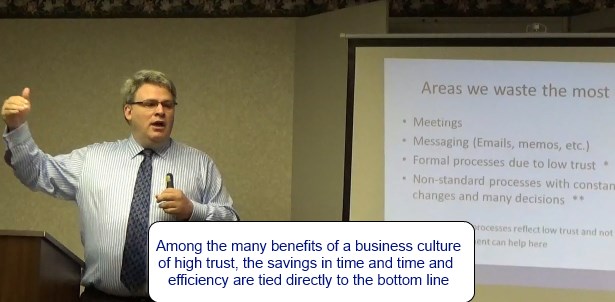What Does High Trust Mean
Phrases come and go in common business trends and we often take for granted that everyone using it understands what it means – or even cares. The “phrase of the day” gets tossed about in journals, LinkedIn stories and blogs and each use varies just a little. So, what does this one mean? What is this culture of high trust and why should we care?
Perhaps we can get away with this little description: A culture of high trust in one where ideas and information shared are done in a way that is consistent with truth, reliable with understanding, and based in full confidence. It is almost idyllic and with an impossible standard for a leader to reach.
Wait? Not Just, “Don’t Lie”?
High trust does not just mean that the teams believes there is no deception involved. It is not merely the absence of lies. More telling, it is the confidence that truth is spoken, and even expected in return. And that when team members are honest, repercussions are not dealt out at a later date. And finally it speaks to the confidence (in both directions) that each means what they say AND that they will do what they do.
 Honesty
Honesty
This is the easiest part of a high trust environment: simply do not lie. But is it easy? Unfortunately there are circumstances where business leaders do have to keep some truth back. We have to guard privacy and confidentiality of subordinates, keep corporate plans secret, and handle conversations with discretion. The fine line exists and we must always be careful not to replace a truth with a lie…but rather to keep some things secret and explain that some things are simply not to be discussed.
Remember also, that feedback is expected and needed. In order for that to happen, it must be safe for team members to respectfully share their issues from time to time. This does not mean always, but to set the expectation that – on the important things – those that may know have a problem can seek consideration and that it is okay to be wrong from time to time.
Understanding
Any team where it is not clear that everyone’s concerns are understood – even if we can not make everyone happy – that they are at least given due consideration. I have attended numerous meetings where parties repeated their points back and forth with little variation each time. Each felt the other was not listening and would not move on until they had explained their point.
The easiest way to end this cycle is to quit trying to correct the other person and stop making your point. Give the other person the full courtesy of listening and let the know you heard them. Only once they felt heard, explain the counter and ask if they understand. Note – that was not agree…just understand the point. Then move on to the decision process in play (boss’s unilateral decision, vote, or some other method).
Action
The best way to complete that foundation for trust is to demonstrate through action the reliability of your words. When one demonstrates that what is said is what is done (“I said it would be done by Tuesday….and here it is”) the reality matches the theory. And with all of these things, that works both ways. Leaders are expected to keep their word, and so are the teams that follow them. But the burden of trust starts always with the leader.
Why?
Sure, teams are fluid and levels of trust vary over time and among individuals, but getting to that point is worth the effort. The results are teams that debate less because they know the goals to achieve and the boundaries for achieving them. Team members feel more connected to the goal of the team and less resentment of other members. The resulting energy can be much greater than anything bought with bonuses and the only cost in an investment in integrity.
Remember, trust is more than just the absence of deception – but the belief in the people and integrity of the effort. Something that takes time to build but moments to lose, so vigilance is key and leadership shines when it is in place.
Everyone has their own version of what is needed for a culture of high trust – what is yours?
